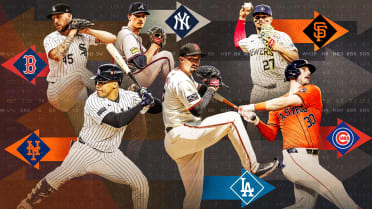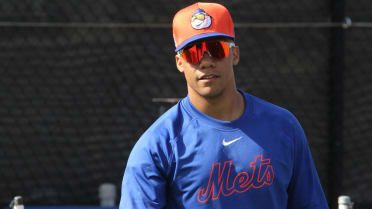Isringhausen, Lidge rejuvenated careers in 'pen
Pair of closers on Hall of Fame ballot for first time
In 2000, the Oakland A's made 27-year-old Jason Isringhausen their closer. Four years later, the Houston Astros made 27-year-old Brad Lidge their closer. Up to that point, both pitchers had sketchy baseball careers. Both had been wrecked by injuries. Both had been tried as starters and, for various reasons, it didn't work out.
Both would then find rich and fulfilling baseball lives as closers.
Looking back through the years, you wonder how many potentially great closers found themselves instead back in their hometowns working real jobs and telling stories about their days as baseball players. Closer as we now know wasn't a role then, wasn't a job. You couldn't go to a manager in the 1940s or '50s and say, "Hey, I realize that I can't make it as a starter, but I can get you three outs every two or three games."
Even after the save became an official stat in the 1960s, nobody thought there was a place on a team for someone who only came in to the game to start the ninth inning when your team was ahead. That didn't really happen until the late '80s and early '90s. Tony La Russa and Dennis Eckersley get a lot of credit/blame for creating the one-inning closer, but it was just as much the work of Bobby Thigpen (who set the saves record with 57 in 1990 and finished fifth in the American League Most Valuable Player voting) and Lee Smith (who transitioned from a more conventional multi-innings reliever to a one-inning closer in the early 1990s and led the league in saves three times).
Because it's still relatively new, and because the reliever role is shifting again, it's hard to know exactly what to do with closers. How good do you have to be to be considered an all-timer? Mariano Rivera? That's easy. Trevor Hoffman will probably get elected to the Hall this year. Billy Wagner will likely not get in, even though he was probably every bit as good as Hoffman. Maybe you need 600 saves to draw enough support.
Isringhausen and Lidge were certainly a step or two below, but still excellent at their peak. Isringhausen was supposed to be a dominant starter. It's strange how that happened. He was a 44th-round pick by the Mets out of junior college in 1991. This was in the days of the old Draft, where you had a year to sign a player after drafting him. Isringhausen just so happened to come up with two other highly touted Mets prospects -- Bill Pulsipher and Paul Wilson -- and once the trio got a catchy nickname (Generation K!), the hype was overwhelming.
In time, all three blew out their arms. Isringhausen had the best career, showing quite a lot of promise his rookie season, going 9-2 with a 2.81 ERA. After that, he had all kinds of problems: Tuberculosis, arm problems, a losing fight with a garbage can. He missed the whole 1998 season, and when he returned, the Mets could not figure out what to do with him. They halfheartedly tried him in the 'pen, but manager Bobby Valentine just couldn't get his arms around moving Isringhausen from the rotation.
"You wouldn't use an Indy car as a taxi in New York City," Valentine said, soon after the Mets traded Isringhausen to Oakland for A's closer Billy Taylor. That didn't work out great for the Mets -- Taylor pitched 18 games for New York, posting an 8.10 ERA before the Mets let him go.
Meanwhile, the A's immediately made Isringhausen their closer and launched a career -- over the next decade, Isringhausen saved 293 games (fourth behind Mariano Rivera, Trevor Hoffman and Billy Wagner), make two All-Star teams and pitch in a World Series. In all, he had 300 saves, the same number as Hall of Famer Bruce Sutter. Isringhausen made more than $56 million in baseball, almost all of it as a closer.
And you know what's funny? By Wins Above Replacement -- admittedly a statistic that some say does not value relievers like it should -- Isringhausen's most productive year was his 1994 rookie season when he started 14 games for the Mets.
Lidge was more like a movie character than a baseball player. You know how Roy Hobbs in "The Natural" was either impossible to get out or entirely helpless on the field, depending on his love life at that particular moment? That was Lidge. He was ridiculously good, or he was barely holding on, there seemed no in between for him. He was destined for epic performances one way or another.
Lidge became a pitcher out of pure necessity. He actually was an outfielder as he came of age, but the outfield at Cherry Creek High School in Englewood, Colo., was filled. Maybe the best high-school player in the country, future first-round pick Donzell McDonald, was in the outfield. So was Mike Goldstein, who was drafted by the Braves. So was Pat Maxwell, who was drafted late by Houston.
Lidge became a pitcher. Eventually, he went to Notre Dame and became a first-round pick of the Astros. Early in his Minor League career, he had serious injuries -- a torn rotator cuff, a broken arm -- and he didn't get up to the big leagues until he was 26. Then, in 2004 and '05, he was absolutely fantastic. He had 71 saves, a 2.07 ERA and averaged 14.2 strikeouts per nine innings. The first year, he finished eighth in the National League Cy Young voting. The second, he made the All-Star team and received an MVP vote.
But that second year, 2005, was the year of the Jose Pujols home run, perhaps the most stunning and powerful moment of the decade. Coming into Game 5 of the NL Championship Series, Lidge had been all but unhittable in the postseason -- he had appeared in 13 games and had allowed just two runs. Postseason batters were hitting .162 against him. He started the ninth inning with a 4-2 lead and it seemed all but certain that he would pitch the Astros to their first World Series.
Lidge struck out the first two batters of the inning -- made them look silly, really. If you had to find the most unhittable pitchers in baseball at that very moment, Lidge would have been in the photograph. Then, he gave up a scratch single and walked Jim Edmonds.
Up came Pujols. Anyone who saw the titanic home run he hit will never forget it.
It was just one bad pitch, one bad moment, but something inside Lidge seemed to break. He always denied that, but his next game -- Game 2 of the World Series against the White Sox -- he gave up a walk-off home run to Scott Podsednik. In Game 4, he didn't pitch badly, but he did give up what turned out to the game-losing run.
And the next season, for reasons hard to explain, Lidge stopped getting people out. He still struck out a lot of people. But his ERA jumped from 2.29 to 5.28. He gave up twice as many home runs as the year before. He threw a bunch of wild pitches. The next year, he lost his closer role. It seemed over for Lidge.
But it wasn't over at all. Before the 2008 season, Lidge was traded to Philadelphia -- and like that, he was fantastic again. He had 41 saves and didn't blow a save all season. The league hit just .198 against him and, even more impressive, slugged just .269. Lidge finished fourth in the Cy Young voting, eighth in the MVP voting, picked up seven saves in the postseason and was on the mound to strike out Eric Hinske and clinch the World Series for Philadelphia. It was the feel-good baseball redemption story of the time.
And then the next year, Lidge was basically unpitchable -- he went 0-8 with a 7.21 ERA and allowed 11 home runs in just 58 2/3 innings.
The next two years, Lidge was good again. Then, he finished his career in Washington at 35 and managed only nine rough innings before announcing his retirement. Let's face it, from beginning to end, Lidge was a hard guy to figure.
Joe Posnanski is a national columnist for MLB.com.



